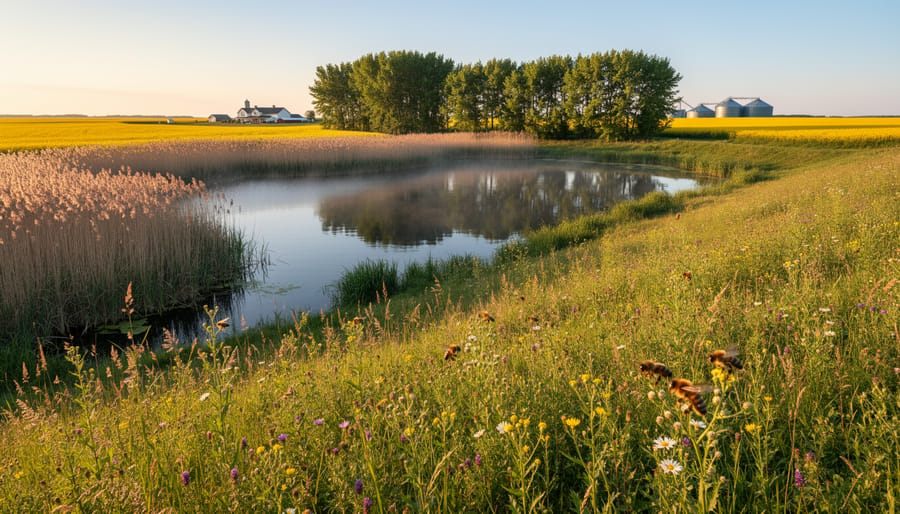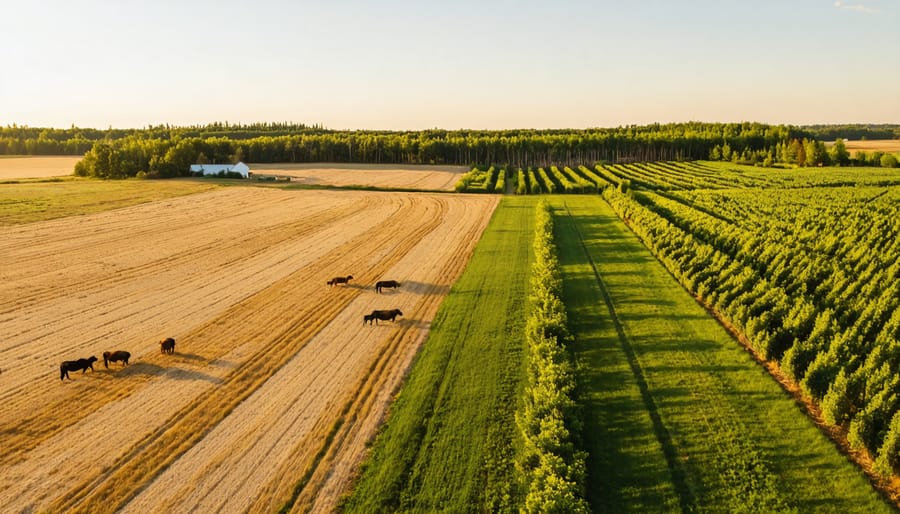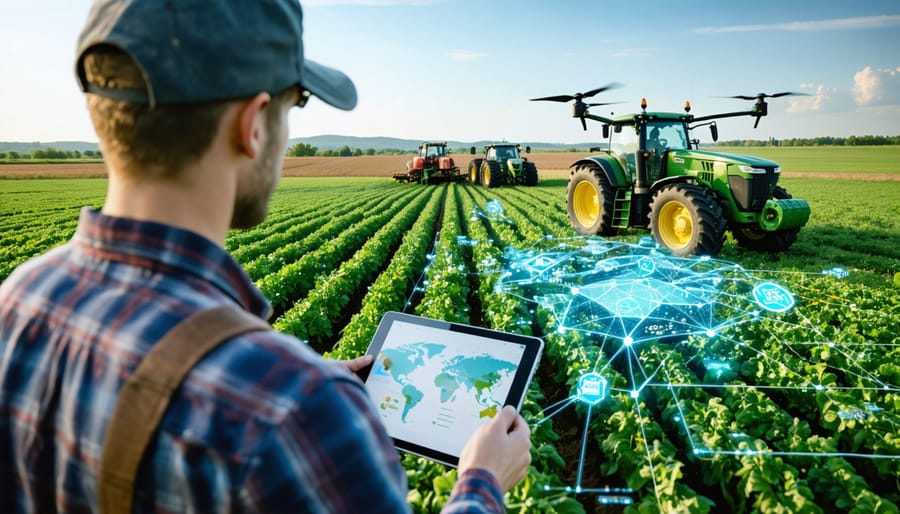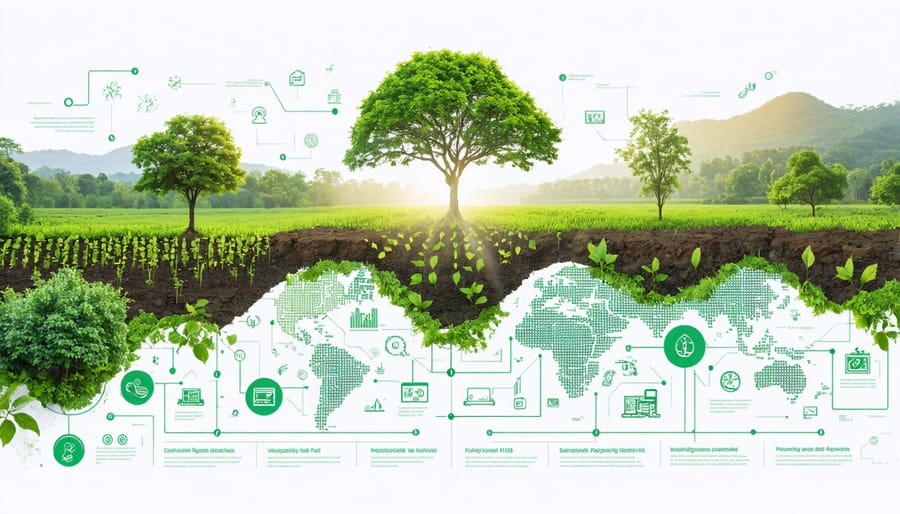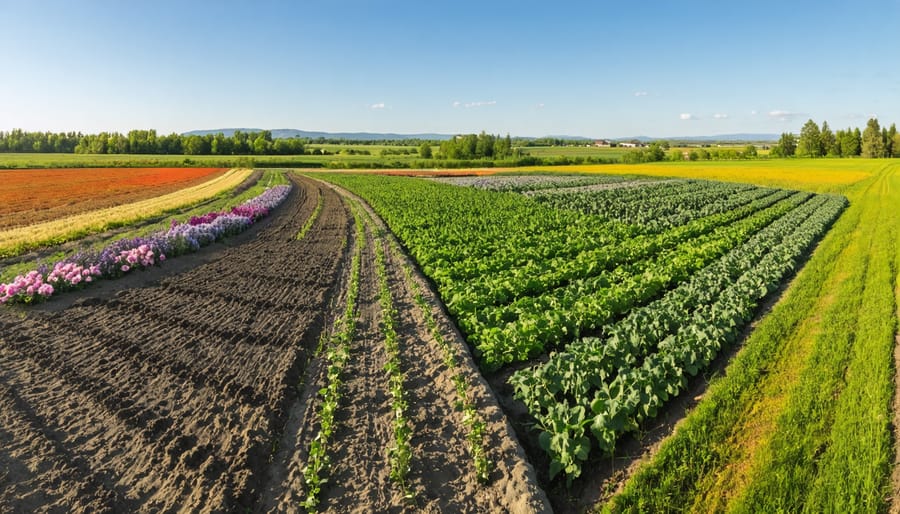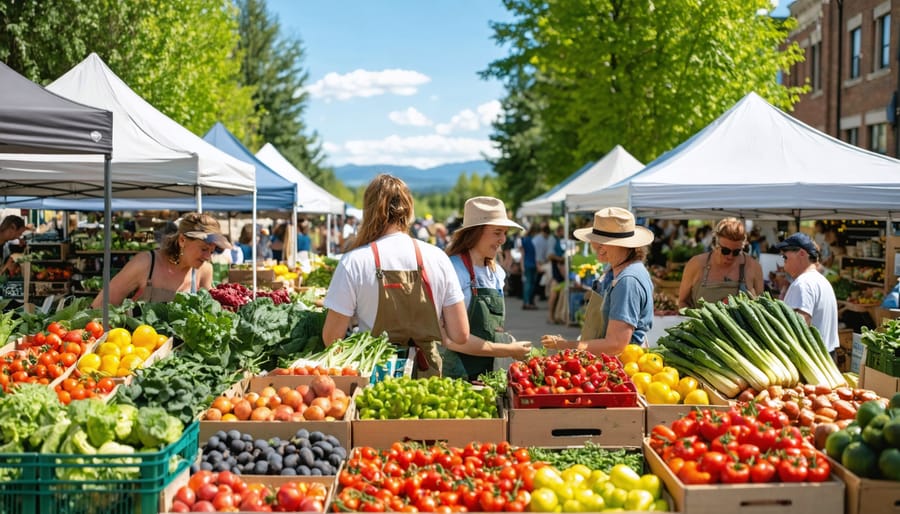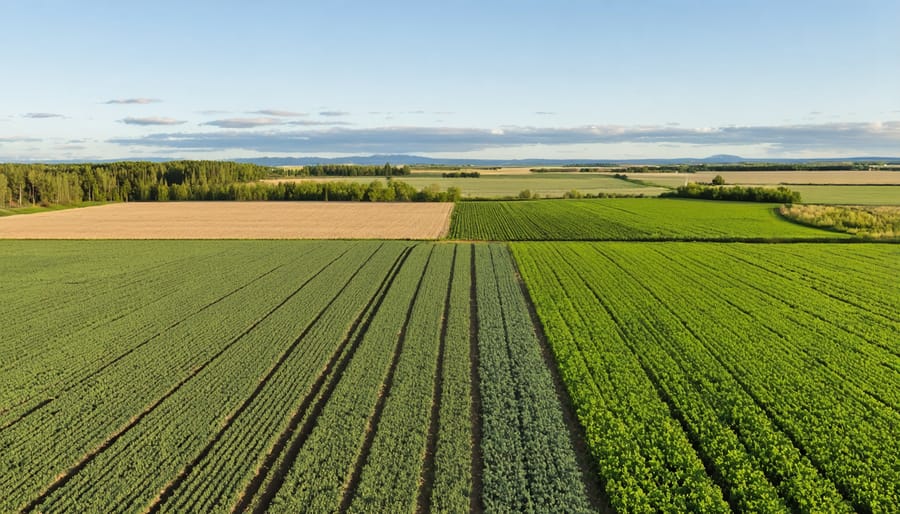Transform your agricultural supply chain by integrating sustainable practices at every touchpoint, from field to market. Modern circular systems in agriculture now enable Alberta farmers to reduce waste by 40% while increasing profit margins through strategic resource management.
Leading Canadian producers have revolutionized traditional supply chains by implementing three core strategies: digitizing inventory tracking to minimize spoilage, establishing direct partnerships with local processors to reduce transportation emissions, and adopting renewable energy solutions for storage facilities. These innovations have cut operating costs by an average of 25% across participating farms in Southern Alberta.
The shift toward green supply chains represents more than environmental stewardship – it’s becoming a critical market advantage. With major retailers now requiring sustainability certification from suppliers, and consumers willing to pay 15% more for environmentally responsible products, implementing green practices isn’t just about conservation – it’s about securing your farm’s future in an evolving marketplace.
The time for incremental changes has passed. Today’s agricultural leaders are completely reimagining their supply chains, creating resilient systems that benefit both the environment and their bottom line.
Building Sustainable Farm-to-Table Networks in Alberta
Local Success Story: The Red Deer Valley Co-op
The Red Deer Valley Co-op has emerged as a shining example of sustainable agriculture in Alberta, demonstrating how local farmers can successfully implement green supply chain practices. Since 2019, this collective of 75 family farms has reduced their carbon footprint by 35% while increasing crop yields by 15%.
The co-op achieved these impressive results by implementing a shared electric delivery fleet for local distributions and establishing a centralized composting facility that processes agricultural waste from member farms. They also developed partnerships with local restaurants and grocery stores to create a closed-loop system for organic waste management.
What sets the Red Deer Valley Co-op apart is their innovative soil health monitoring program. Each member farm uses soil sensors and data analytics to optimize fertilizer use, resulting in a 40% reduction in synthetic fertilizer applications across the network. The co-op also maintains a seed-sharing program that promotes crop diversity and resilience.
Their success has inspired neighboring farming communities, with similar initiatives now starting in Lacombe and Rocky Mountain House. The co-op regularly hosts workshops for local farmers, sharing their experiences and helping others transition to more sustainable practices.
Carbon Footprint Reduction Through Smart Distribution
Smart distribution practices are revolutionizing how Alberta farmers reduce their environmental impact while maintaining efficient operations. By implementing proven carbon footprint reduction strategies, local producers are seeing significant improvements in their transportation efficiency.
Route optimization software has become a game-changer for many Alberta farms, reducing fuel consumption by up to 25% through better delivery planning. Consider the experience of the Morrison Family Farm in Red Deer, which cut their weekly fuel usage by 300 litres after adopting smart routing technology.
Consolidating shipments through community-based logistics partnerships is another effective approach. Several farmers in the Leduc area have formed transportation cooperatives, sharing delivery vehicles and coordinating pickup schedules to minimize empty return trips.
Load optimization is equally important. Using standardized packaging and proper stacking techniques can increase cargo capacity by up to 30%. Many successful operations are also switching to hybrid or electric delivery vehicles for short-haul routes, while incorporating aerodynamic modifications on long-haul trucks to improve fuel efficiency.
Remember, even small changes like regular vehicle maintenance and driver training in fuel-efficient practices can lead to meaningful reductions in your operation’s carbon footprint.
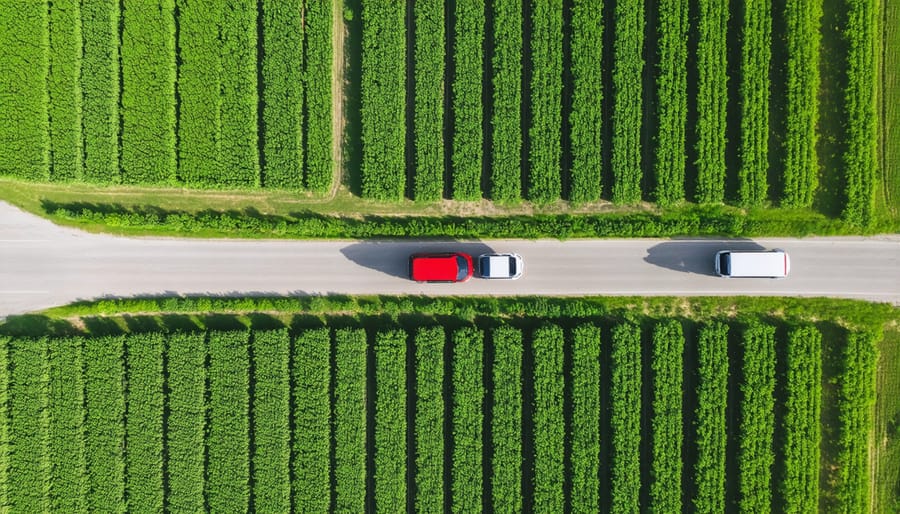
Technology’s Role in Greening Agricultural Supply Chains
Smart Tracking Systems
Modern tracking systems are revolutionizing how Alberta farmers monitor their agricultural supply chains, making them more efficient and environmentally friendly. By implementing Internet of Things (IoT) sensors and smart tracking devices, farmers can now monitor everything from soil conditions to product transportation in real-time.
Take the example of the Morrison Family Farm near Lethbridge, which reduced its carbon footprint by 15% after implementing smart tracking systems. Their IoT sensors monitor fuel consumption in delivery vehicles and automatically optimize routes, cutting down on unnecessary trips and emissions.
These systems also help prevent food waste through precise temperature and humidity monitoring during transport. Local producer Sarah Thompson shares, “Since installing tracking sensors in our grain storage facilities, we’ve virtually eliminated spoilage losses and reduced energy consumption by 20%.”
Key benefits of smart tracking systems include:
– Real-time monitoring of product conditions
– Automated inventory management
– Reduced fuel consumption through route optimization
– Better quality control through continuous monitoring
– Improved traceability for food safety
For beginners, starting with basic GPS tracking and temperature sensors is recommended. Many local agricultural technology providers offer starter packages specifically designed for Alberta farms, with options to scale up as needed. The initial investment typically pays for itself within 12-18 months through reduced waste and improved efficiency.
Remember to choose systems that can integrate with your existing equipment and provide easy-to-understand data reports. Local agriculture extension offices often provide guidance on selecting and implementing these technologies.

Blockchain for Supply Chain Transparency
Blockchain technology is revolutionizing how we track and verify sustainable practices in agricultural supply chains across Alberta. Think of blockchain as a digital ledger that creates an unalterable record of every step in your produce’s journey from field to market.
Calgary-based farmer Tom Peterson implemented blockchain tracking for his organic wheat operation in 2022. “It’s like having a digital passport for every bushel,” he explains. “Our customers can scan a QR code and see exactly how we’ve maintained sustainable practices throughout the growing season.”
The system works by recording key data points: planting dates, fertilizer applications, water usage, and harvest conditions. Each entry is verified by multiple participants in the supply chain, making it nearly impossible to alter records after the fact. This transparency helps build trust with processors and consumers while ensuring compliance with sustainability certifications.
Local agricultural co-ops are now offering blockchain implementation support for small to medium-sized farms. The Southern Alberta Agricultural Innovation Network provides workshops on getting started with blockchain technology, with costs typically ranging from $5,000 to $15,000 for initial setup.
For farmers considering blockchain adoption, start small by tracking one crop or product line. Focus on recording essential sustainability metrics like water usage and carbon emissions. As you become more comfortable with the system, you can expand tracking to include more detailed information about your sustainable farming practices.
Waste Reduction Strategies in the Supply Chain
Packaging Innovation
Modern agriculture is embracing sustainable packaging innovations that reduce environmental impact while maintaining product quality. Alberta farmers are leading the way with biodegradable solutions made from agricultural byproducts, such as grain straw and corn husks, which naturally decompose after use.
Local success stories include the Thompson Valley Farm Co-op, which switched to hemp-based packaging for their organic produce, reducing plastic usage by 75% while supporting local hemp farmers. Their innovative approach includes returnable containers made from compressed wheat stalks, creating a circular economy within the community.
Many Alberta producers are now using mushroom-based packaging materials, which are grown using agricultural waste and create protective cushioning that’s completely compostable. These materials have proven particularly effective for shipping delicate produce and eggs, with a 40% reduction in product damage compared to traditional packaging.
Cost-effective solutions are also emerging, such as edible packaging films made from pulse crops like peas and lentils. These innovations not only address environmental concerns but also create new revenue streams for farmers who can supply raw materials for packaging production.

Cold Chain Optimization
In Alberta’s agricultural sector, efficient cold chain management is crucial for maintaining product quality while reducing environmental impact. Modern energy-efficient storage solutions, like variable-frequency drive refrigeration systems, can cut energy consumption by up to 30% compared to traditional units. These systems are particularly valuable during our hot prairie summers and extreme winter conditions.
Local success stories include the Olds-based Morrison Farms, which implemented smart temperature monitoring systems in their storage facilities, reducing energy usage while maintaining optimal conditions for their root vegetables. Their solar-powered cold storage facility serves as a model for sustainable cold chain practices in our region.
For transportation, many Alberta farmers are switching to hybrid refrigeration units that can run on both electric and diesel power, allowing for significant fuel savings during long-haul deliveries. Some operations are also adopting phase-change materials for temperature control, which maintain consistent temperatures without constant energy input.
Cooperative approaches are gaining traction, with neighbouring farms sharing cold storage facilities to maximize efficiency. The Southern Alberta Cold Chain Initiative has helped small-scale producers access energy-efficient storage solutions through cost-sharing programs, making sustainable cold chain practices more accessible to our farming community.
Building Resilience Through Partnerships
Working with Local Processors
Working with local processors is a game-changer for Alberta farmers looking to strengthen their green supply chains. By partnering with processors within 100-200 kilometres, farms can significantly reduce transportation emissions while supporting regional economic growth. The Lacombe Food Processing Hub serves as an excellent example, where over 30 local farms have cut their transport distances by an average of 75% through collaborative processing arrangements.
Recent success stories include the Red Deer Valley Organic Cooperative, which established partnerships with three local processors, reducing their carbon footprint by 40% in just two years. These processors specialize in value-added products like organic flour, cold-pressed canola oil, and pulse-based products, creating additional revenue streams for participating farms.
To build effective relationships with local processors, consider these practical steps:
– Start by mapping out processors within your region using resources from Alberta Agriculture and Forestry
– Attend regional agricultural trade shows to network with potential processing partners
– Join or form producer groups to achieve the volume requirements that make local processing viable
– Invest in on-farm storage solutions to maintain product quality until processing is available
The Growing Forward 3 program offers grants for farmers looking to upgrade their storage facilities or contribute to local processing initiatives. Remember, strengthening regional processing capabilities isn’t just about environmental benefits – it’s about building resilient local food systems that can weather supply chain disruptions while supporting our rural communities.
Consumer Education Programs
Consumer education plays a vital role in building sustainable agricultural supply chains across Alberta. When farmers engage directly with consumers through educational initiatives, they create lasting partnerships that benefit both parties. Many Alberta farmers have found success through farm-to-table education programs, where consumers learn firsthand about sustainable farming practices and their impact on food quality.
Local agricultural societies and farmer-led organizations are increasingly offering workshops and field days that showcase green supply chain practices. These events help consumers understand the journey their food takes from field to plate, including sustainable transportation methods, storage solutions, and packaging choices that reduce environmental impact.
Several successful programs in the region include virtual farm tours, which have gained popularity since 2020. These online experiences allow urban consumers to witness sustainable farming practices without leaving their homes. Additionally, farmers’ markets across Alberta have implemented QR code systems that let shoppers trace their produce’s journey and learn about the sustainable practices used in its production.
Social media has become another powerful tool for consumer education. Many Alberta farmers use platforms like Instagram and YouTube to share their daily sustainable farming practices, creating transparent connections with their customers. These digital initiatives have helped build trust and understanding between producers and consumers, leading to increased support for local, sustainable agriculture.
To strengthen these educational efforts, many farmers collaborate with local schools and community organizations, offering hands-on learning experiences that demonstrate the importance of sustainable supply chains in agriculture.
As we’ve explored throughout this article, implementing green supply chain practices isn’t just good for the environment – it’s good for your farm’s bottom line and long-term sustainability. By starting with small, manageable changes like optimizing transportation routes and reducing packaging waste, Alberta farmers can build momentum towards larger sustainability goals.
Remember to leverage local resources and connect with fellow farmers who have successfully implemented these practices. The Alberta Farm Sustainability Extension Working Group offers valuable support and guidance for those taking their first steps toward greener operations.
Key action steps to get started include:
– Conducting a supply chain audit to identify areas for improvement
– Setting realistic, measurable sustainability goals
– Investing in energy-efficient equipment and renewable energy solutions
– Building relationships with eco-conscious suppliers and partners
– Documenting and sharing your sustainability journey to inspire others
By embracing green supply chain practices, we’re not just improving our individual operations – we’re strengthening our farming community and securing a more sustainable future for Alberta agriculture. Start small, stay committed, and remember that every step toward sustainability counts.
Together, we can build resilient, environmentally responsible supply chains that benefit our farms, our communities, and our planet for generations to come.


